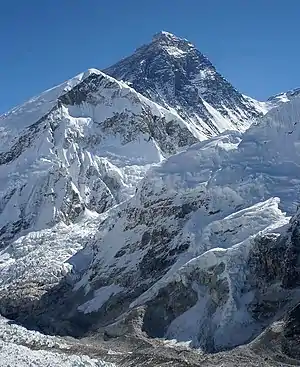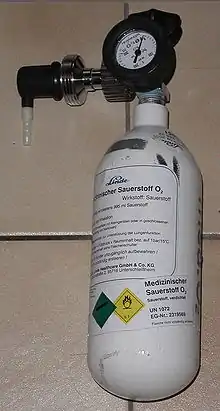Death zone
In mountaineering, the death zone refers to altitudes above a certain point where the pressure of oxygen is insufficient to sustain human life for an extended time span. This point is generally tagged as 8,000 m (26,000 ft, less than 356 millibars of atmospheric pressure).[1] The concept was first conceived in 1953 by Edouard Wyss-Dunant, a Swiss doctor, who called it the lethal zone.[2] All 14 peaks above 8000m in the death zones are located in the Himalaya and Karakoram of Asia.

Many deaths in high-altitude mountaineering have been caused by the effects of the death zone, either directly by loss of vital functions or indirectly by wrong decisions made under stress, or physical weakening leading to accidents. An extended stay above 8,000 metres (26,247 ft) without supplementary oxygen will result in deterioration of bodily functions and death.[3][4][5]
Physiological background
The human body functions best at sea level where the atmospheric pressure is 101,325 Pa or 1013.25 millibars (or 1 atm, by definition). The concentration of oxygen (O2) in sea level air is 20.9% so the partial pressure of O2 (PO2) is about 21.2 kPa. In healthy individuals, this saturates hemoglobin, the oxygen-binding red pigment in red blood cells.[6]
Atmospheric pressure decreases exponentially with altitude while the O2 fraction remains constant to about 100 km (62 mi), so PO2 decreases exponentially with altitude as well. It is about half of its sea level value at 5,000 m (16,000 ft), the altitude of the Mount Everest base camp, and only a third at 8,848 m (29,029 ft), the summit of Mount Everest.[7] When PO2 drops, the body responds with altitude acclimatization.[8] Additional red blood cells are manufactured; the heart beats faster; non-essential body functions are suppressed, food digestion efficiency declines (as the body suppresses the digestive system in favor of increasing its cardiopulmonary reserves);[9] and one breathes more deeply and more frequently. But acclimatization requires days or even weeks. Failure to acclimatize may result in altitude sickness, including high altitude pulmonary edema (HAPE) or cerebral edema (HACE).[10][11]
Humans have survived for 2 years at 5,950 m (19,520 ft) [475 millibars of atmospheric pressure], which appears to be near the limit of the permanently tolerable highest altitude.[12] At extreme altitudes, above 7,500 m (24,600 ft) [383 millibars of atmospheric pressure], sleeping becomes very difficult, digesting food is near-impossible, and the risk of HAPE or HACE increases greatly.[10][13][14]

In the death zone and higher, no human body can acclimatize. The body uses up its store of oxygen faster than it can be replenished. An extended stay in the zone without supplementary oxygen will result in deterioration of body functions, loss of consciousness and, ultimately, death.[1][4][5] Scientists at the High Altitude Pathology Institute in Bolivia dispute the existence of a death zone, based on observation of extreme tolerance to hypoxia in patients with chronic mountain sickness and normal fetuses in-utero, both of which present pO2 levels similar to those at the summit of Mount Everest.[15]
Mountaineers use supplemental oxygen in the death zone to reduce deleterious effects. An open-circuit oxygen apparatus was first tested on the 1922 and 1924 British Mount Everest expeditions; the bottled oxygen taken in 1921 was not used (see George Finch and Noel Odell). In 1953 the first assault party of Tom Bourdillon and Charles Evans used closed-circuit oxygen apparatus. The second (successful) party of Ed Hillary and Tenzing Norgay used open-circuit oxygen apparatus; after ten minutes taking photographs on the summit without his oxygen set on, Hillary said he "was becoming rather clumsy-fingered and slow-moving".[16]
Physiologist Griffith Pugh was on the 1952 and 1953 expeditions to study the effects of cold and altitude; he recommended acclimatising above 15,000 feet (4,600 m) for at least 36 days and the use of closed-circuit equipment. He further studied the ability to acclimatise over several months on the 1960-61 Silver Hut expedition to the Himalayas.
In 1978, Reinhold Messner and Peter Habeler made the first ascent of Mount Everest without supplemental oxygen.
See also
References
- "Everest:The Death Zone". Nova. PBS. 1998-02-24.
- Wyss-Dunant, Edouard (1953). "Acclimatisation" (PDF). The Mountain World: 110–117. Retrieved March 10, 2013.
- Darack, Ed (2002). Wild winds: adventures in the highest Andes. p. 153. ISBN 978-1-884980-81-7.
- Huey, Raymond B.; Eguskitza, Xavier (2 July 2001). "Limits to human performance: elevated risks on high mountains". Journal of Experimental Biology. 204 (18): 3115–9. PMID 11581324.
- Grocott, Michael P.W.; Martin, Daniel S.; Levett, Denny Z.H.; McMorrow, Roger; Windsor, Jeremy; Montgomery, Hugh E. (2009). "Arterial Blood Gases and Oxygen Content in Climbers on Mount Everest" (PDF). N Engl J Med. 360 (2): 140–9. doi:10.1056/NEJMoa0801581. PMID 19129527.
- "Hypoxia, Oxygen, and Pulse Oximetry" (PDF). FlightState Pulse Oximeter. Retrieved 2006-12-29.
- "Introduction to the Atmosphere". PhysicalGeography.net. Retrieved 2006-12-29.
- Muza, SR; Fulco, CS; Cymerman, A (2004). "Altitude Acclimatization Guide". US Army Research Inst. Of Environmental Medicine Thermal and Mountain Medicine Division Technical Report (USARIEM-TN-04-05). Retrieved 2009-03-05.
- Westerterp, Klaas (June 1, 2001). "Energy and Water Balance at High Altitude". News in Physiological Sciences. 16 (3): 134–137. doi:10.1152/physiologyonline.2001.16.3.134. PMID 11443234.
- Cymerman, A; Rock, PB. "Medical Problems in High Mountain Environments. A Handbook for Medical Officers". USARIEM-TN94-2. US Army Research Inst. of Environmental Medicine Thermal and Mountain Medicine Division Technical Report. Retrieved 2009-03-05. Cite journal requires
|journal=(help) - "Outdoor Action Guide to High Altitude: Acclimatization and Illnesses". Outdoor Action First Aid & Safety Training. Retrieved 2006-12-29.
- West, JB (2002). "Highest permanent human habitation". High Altitude Medical Biology. 3 (4): 401–407. doi:10.1089/15270290260512882. PMID 12631426.
- Rose MS, Houston CS, Fulco CS, Coates G, Sutton JR, Cymerman A (1988). "Operation Everest. II: Nutrition and body composition". J. Appl. Physiol. 65 (6): 2545–51. doi:10.1152/jappl.1988.65.6.2545. PMID 3215854. Retrieved 2009-03-05.
- Kayser B (1992). "Nutrition and high altitude exposure". Int J Sports Med. 13 Suppl 1: S129–32. doi:10.1055/s-2007-1024616. PMID 1483750.
- Zubieta-Castillo, G.; Zubieta-Calleja, G.R.; Zubieta-Calleja, L.; Zubieta-Castillo, Nancy (2008). "Facts that Prove that Adaptation to life at Extreme Altitude (8842m) is possible" (PDF). Adaptation Biology and Medicine. 5 (Suppl 5): 348–355.
- Hunt, John (1953). The Ascent of Everest. London: Hodder & Stoughton. p. 206.